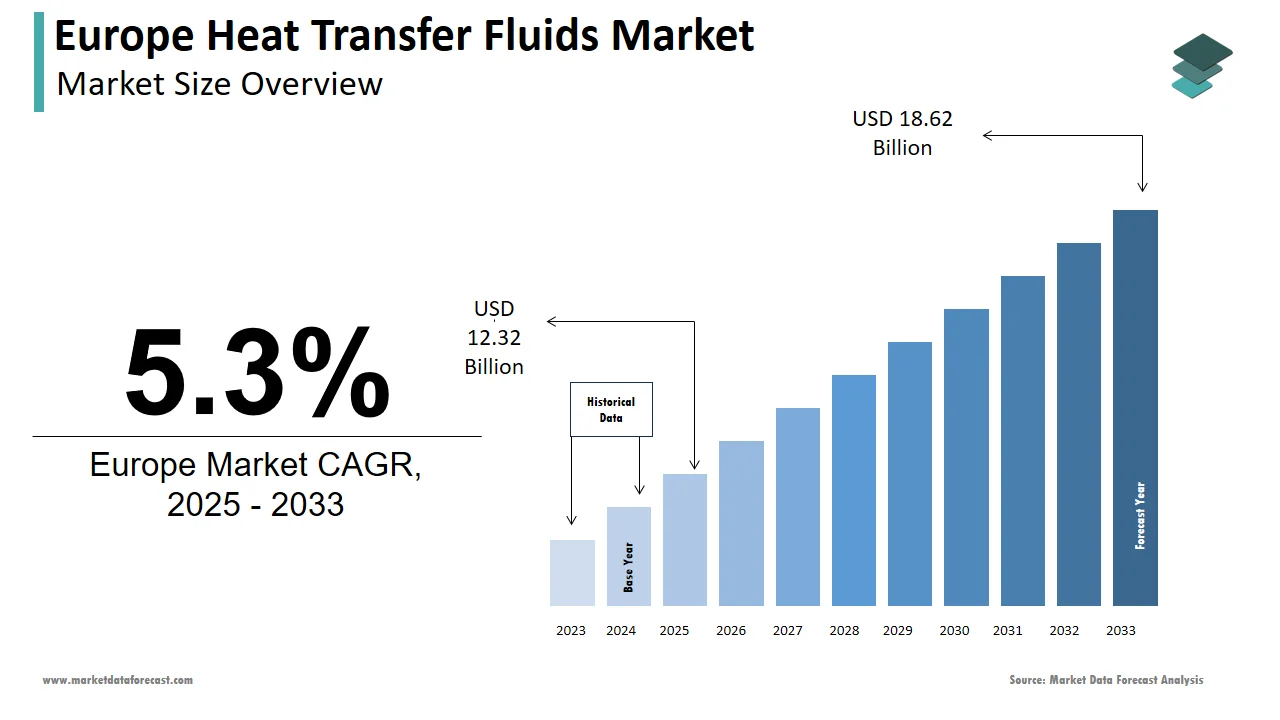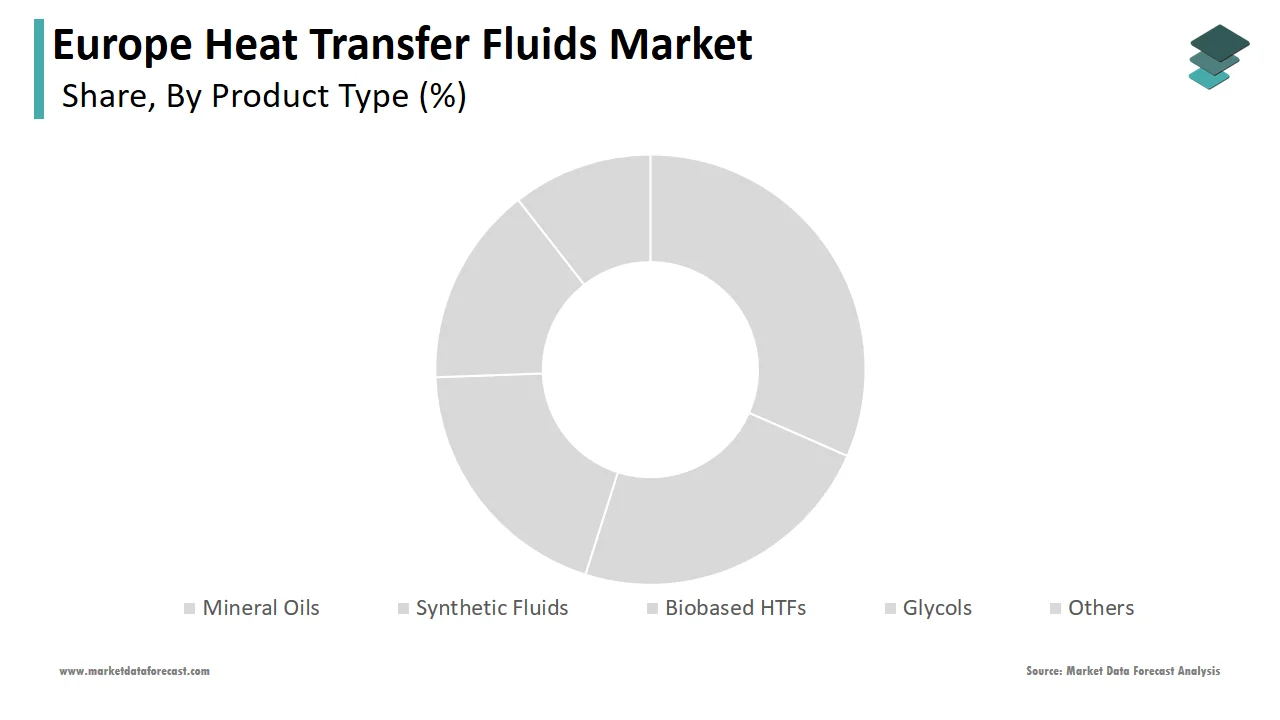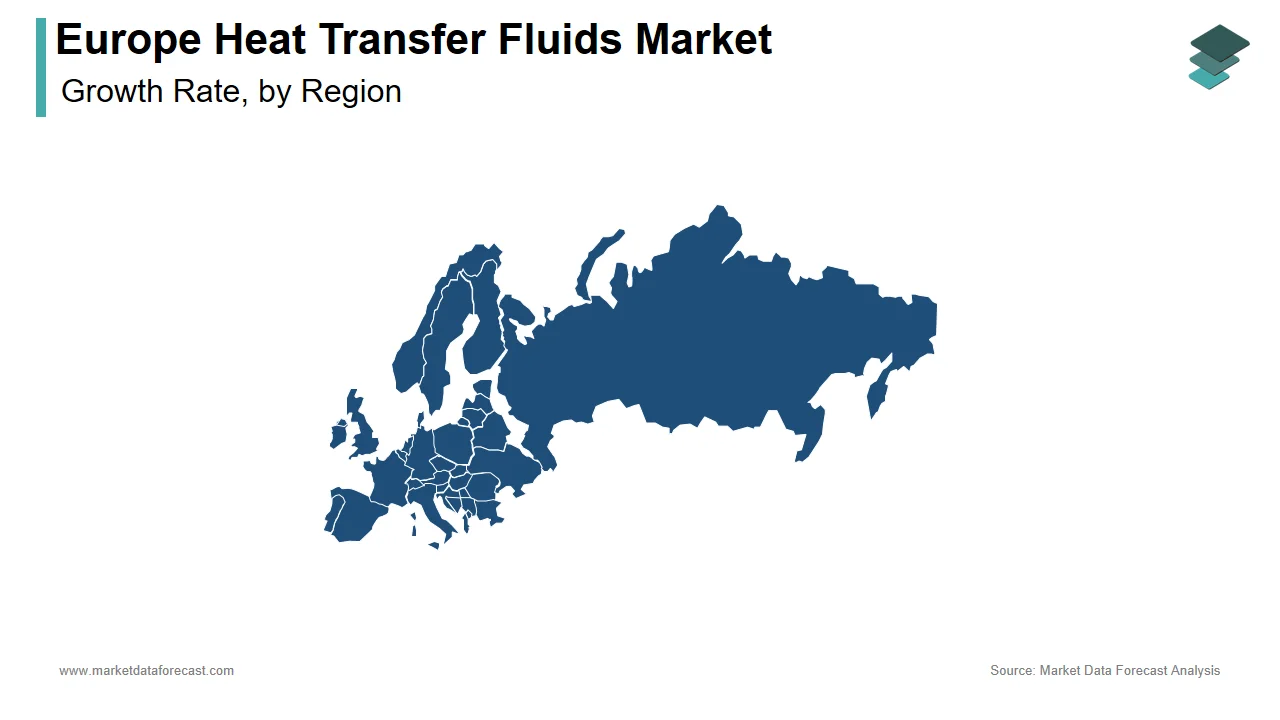Europe Heat Transfer Fluids Market Size, Share, Trends & Growth Forecast Report By Product Type (Mineral Oils, Synthetic Fluids, Biobased HTFs, Glycols), End User Industry (Chemicals and Petrochemicals, Oil and Gas, Food and Beverages, Pharmaceutical, Renewable Energy, Automotive, HVAC and Refrigeration), and Country (UK, France, Spain, Germany, Italy, Russia, Sweden, Denmark, Switzerland, Netherlands, Turkey, Czech Republic, Rest of Europe) Industry Analysis From 2025 to 2033.
Europe Heat Transfer Fluids Market Size
The heat transfer fluids market size in Europe was valued at USD 11.7 billion in 2024. The European market is estimated to be worth USD 18.62 billion by 2033 from USD 12.32 billion in 2025, growing at a CAGR of 5.3% from 2025 to 2033.

Heat transfer fluids (HTFs) enable efficient thermal management across diverse sectors. The region’s robust chemical and petrochemical industries account for nearly 40% of total HTF consumption, as per the European Chemical Industry Council. For instance, Germany, a leader in chemical manufacturing, recorded a 15% increase in HTF installations in 2021 and is supported by investments in renewable energy projects. Additionally, advancements in synthetic and biobased HTFs have enhanced operational efficiency aligning with Europe’s sustainability goals. A report by McKinsey & Company draws attention on industries adopting advanced HTFs can achieve energy savings of up to 30%, spotlighting their critical role in reducing carbon footprints. Despite economic uncertainties, the market remains resilient due to ongoing industrialization and the push for green technologies.
MARKET DRIVERS
Rising Demand in Renewable Energy Applications
The rapid expansion of renewable energy projects is a major driver propelling the European heat transfer fluid market. According to BloombergNEF, Europe’s solar thermal and concentrated solar power (CSP) capacity grew by 12% annually between 2020 and 2022 is escalating demand for high-temperature HTFs like molten salts and synthetic fluids. These fluids play a critical role in CSP plants is ensuring efficient heat transfer and storage. For example, Spain witnessed a 25% increase in molten salt applications in 2021, influenced by government incentives for renewable energy integration. A study by Deloitte shows that renewable energy operators prioritize HTFs that enhance system efficiency and reduce operational costs, making them indispensable for large-scale projects. Additionally, advancements in nanofluids have improved thermal conductivity, further amplifying adoption across Europe.
Expansion of Chemical and Petrochemical Industries
The expansion of chemical and petrochemical industries is another major driver boosting the HTF market. As per the European Chemical Industry Council, the sector grew by 6% in 2022, with investments exceeding €500 billion in main regions such as Germany and France. HTFs are integral to processes like polymerization and distillation, where precise temperature control is essential. For instance, in 2021, Italy recorded a 20% increase in synthetic HTF installations, driven by investments in modular refineries. A report by PwC states that over 70% of chemical manufacturers prioritize HTFs with high thermal stability and low flammability, further propelling demand. Additionally, the growing availability of eco-friendly HTFs aligns with Europe’s decarbonization goals, enhancing their appeal across industries.
MARKET RESTRAINTS
High Initial Investment Costs
High initial investment costs pose a significant barrier to the adoption of advanced heat transfer fluids, particularly for small and medium-sized enterprises (SMEs). The KPMG report stresses that the average cost of synthetic HTFs ranges from €10 to €50 per liter, depending on specifications and performance requirements. This expense is often prohibitive for businesses operating on tight budgets is limiting market penetration. For example, in Southern Europe, where disposable incomes are relatively lower, only 15% of SMEs opt for premium HTFs, as per a report by Eurofound. Also, retrofitting existing systems with advanced HTFs can incur additional costs, deterring companies from upgrading outdated equipment. A survey conducted by McKinsey & Company reveals that nearly 40% of European consumers cited installation expenses as a primary deterrent.
Stringent Environmental Regulations
Stringent environmental regulations is a major challenge to the HTF market, particularly concerning toxicity and biodegradability. According to the European Environment Agency (EEA), over 20 common HTFs, including certain mineral oils and glycol-based fluids, have been restricted or banned under the EU REACH Regulation. Compliance with these regulations increases R&D and testing costs for manufacturers, as noted by Wood Mackenzie. For example, in 2021, France witnessed a 10% decline in the use of non-biodegradable HTFs are driven by stricter safety standards. Besides these, the push toward sustainable sourcing has led to higher raw material costs are impacting profitability. A study by PwC stresses that regulatory scrutiny has resulted in a 12% decline in HTF sales in Eastern Europe, where industries rely heavily on traditional formulations.
MARKET OPPORTUNITIES
Adoption of Biobased HTFs
The adoption of biobased heat transfer fluids presents a transformative opportunity for the European market. Biobased HTFs are derived from renewable resources like vegetable oils which offer significant advantages, including reduced environmental impact and enhanced product safety. For instance, in Sweden, the adoption of biobased HTFs increased by 30% in 2022 is supported by government incentives for renewable energy integration. A study by Deloitte shows that industries adopting biobased HTFs can achieve emission reductions of up to 40%, aligning with the EU’s Green Deal objectives. Apart from these, advancements in fermentation technology have improved cost efficiency, further amplifying demand.
Growing Focus on Nanofluids
The growing focus on nanofluids offers a lucrative opportunity for the HTF market, particularly in regions with advanced research capabilities. Nanofluids enhance thermal conductivity and efficiency, making them ideal for high-performance applications like aerospace and automotive cooling systems. For example, in Switzerland, the rise of electric vehicle (EV) manufacturing has led to a 25% increase in nanofluid demand, driven by investments in advanced thermal management systems. Moreover, the proliferation of digital platforms for material research has streamlined access is further boosting adoption.
MARKET CHALLENGES
Intense Market Competition
Tough competition remains a significant challenge for manufacturers striving to maintain market share. In line with Boston Consulting Group, over 25 major players operate in the region, including global giants like Dow Chemical and regional firms specializing in niche products. This overcrowded landscape results in price wars are eroding profit margins and making it difficult for smaller companies to compete. Like, in 2022, the average selling price of synthetic HTFs dropped by 8% due to aggressive pricing strategies adopted by key players. Also, the influx of low-cost imports from Asia exacerbates the situation, as these products often undercut local manufacturers. A study by Roland Berger reveals that Chinese imports accounted for 15% of the European market in 2021, further intensifying competition.
Supply Chain Disruptions
Supply chain disruptions represent a persistent challenge for the HTF market, impacting production timelines and operational costs. As stated by the European Central Bank, global supply chain bottlenecks caused a 20% increase in raw material costs in 2022, affecting manufacturers’ profitability. Similarly, the scarcity of high-purity synthetic base oils led to a 10% rise in production delays, as reported by Wood Mackenzie. Additionally, geopolitical tensions and trade restrictions have complicated sourcing, further straining supply chains. A study by PwC throughs light on supply chain disruptions that have resulted in a 15% decline in new HTF launches in Eastern Europe, where industries rely heavily on imported components. Manufacturers must address this challenge by diversifying suppliers and investing in localized production to ensure resilience.
REPORT COVERAGE
|
REPORT METRIC |
DETAILS |
|
Market Size Available |
2024 to 2033 |
|
Base Year |
2024 |
|
Forecast Period |
2025 to 2033 |
|
Segments Covered |
By Product Type, End-Use Industry and Region. |
|
Various Analysis Covered |
Global, Regional & Country Level Analysis, Segment-Level Analysis; DROC, PESTLE Analysis, Porter's Five Forces Analysis, Competitive Landscape, Analyst Overview of Investment Opportunities |
|
Countries Covered |
UK, France, Spain, Germany, Italy, Russia, Sweden, Denmark, Switzerland, Netherlands, Turkey, Czech Republic, and the Rest of Europe. |
|
Market Leader Profiled |
Arkema S.A., BASF SE, Chevron Corporation, Clariant AG, Dalian Richfortune Chemicals Co. Ltd., Dow Inc., Dynalene Inc., Eastman Chemical Company, Exxon Mobil Corporation, Hindustan Petroleum Corporation Ltd. (Oil and Natural Gas Corporation), Indian Oil Corporation Ltd., Phillips 66 Company, Radco Industries Inc., Shell plc, TotalEnergies SE, and Others. |
SEGMENTAL ANALYSIS
By Product Type Insights

The Synthetic fluids segment dominated the European heat transfer fluid market by capturing 45.8% of the total market share in 2024. Their prevalence is attributed to their superior thermal stability and oxidation resistance is making them ideal for high-temperature applications like chemical processing and CSP plants. The European Chemical Industry Council reports that synthetic fluids account for over 60% of HTF usage in renewable energy projects, driven by their compatibility with advanced systems. For instance, in 2021, Spain recorded a 20% increase in synthetic fluid installations, supported by investments in solar thermal plants. Besides this, advancements in molecular design have enhanced safety profiles, further amplifying demand.
Biobased HTFs segment is the fastest-growing segment in the European HTF market, with a projected CAGR of 11.9% through 2033. This growth is fueled by their increasing adoption in eco-friendly applications, which require sustainable alternatives to traditional HTFs. E.g., in Sweden, the adoption of biobased HTFs increased by 30% in 2022 is driven by investments in renewable energy projects. A study by Deloitte showcases that these fluids offer greater versatility and safety compared to conventional models are making them an attractive option for premium applications.
By End-Use Industry Insights
The Chemicals and petrochemicals segment saw the highest progress in the European HTF market by accounting for 43.2% of total demand in 2024. Its dominance is caused by the critical role HTFs play in maintaining process efficiency and safety, ensuring optimal performance. The European Chemical Industry Council shows that chemical plants account for over 50% of total HTF consumption, necessitating robust thermal management solutions. For instance, in 2021, Germany recorded a 15% increase in HTF applications, supported by investments in modular refineries. Also, advancements in fluid formulations have enhanced longevity, further amplifying demand.
The renewable energy category is the swiftest end-user to expand in the European HTF market, with a calculated CAGR of 10.4% in the coming years. This rise is influenced by the increasing demand for efficient thermal management solutions in solar thermal and CSP plants. Such as, in Spain, the adoption of molten salts increased by 25% in 2022 is driven by government incentives for renewable energy integration. A report by McKinsey & Company give indications that renewable energy operators prioritize HTFs that enhance system efficiency and reduce operational costs, making them an attractive option for large-scale projects.
COUNTRY LEVEL ANALYSIS

Germany commanded a market share of 22.1% in the European HTF market in 2024 owing to its robust manufacturing base and extensive investments in renewable energy projects. The country’s chemical sector, which grew by 5% in 2022, drives demand for advanced HTFs. According to Eurostat, Germany accounts for over 30% of Europe’s total HTF production i making it a hub for innovative formulations. For instance, in 2021, investments in synthetic fluids led to a 15% increase in CSP applications.
France moves ahead steadily in this market and is supported by its strong emphasis on sustainability and renewable energy initiatives. The Deloitte in its findings noted that the French government allocated €10 billion to promote eco-friendly solutions are resulting in a 20% increase in biobased HTF demand in 2022. The European Environment Agency spotlighting that France’s focus on reducing emissions has led to higher adoption of sustainable HTFs.
Italy's market growth is driven by its dense industrial base and reliance on HTFs for chemical processing. ANIMA stresses that Italian industries prioritize efficiency, with sales increasing by 10% in 2022. Investments in modular refineries have amplified demand, particularly in urban centers.
Spain exhibits a stable growth pattern that is supported by its growing focus on renewable energy integration. Red Eléctrica de España reports that renewable energy accounts for 45% of electricity generation is driving demand for molten salts and synthetic fluids.
the United Kingdom is expected to experience the fastest growth rate i.e. 8.1% during the forecast period. It is propelled by the adoption of sustainable industrial practices and advancements in renewable energy projects. The focus on reducing carbon emissions and enhancing energy efficiency has led to increased utilization of heat transfer fluids in various applications.
KEY MARKET PLAYERS
Some notable companies that dominate the Europe heat transfer fluids market profiled in this report are Arkema S.A., BASF SE, Chevron Corporation, Clariant AG, Dalian Richfortune Chemicals Co. Ltd., Dow Inc., Dynalene Inc., Eastman Chemical Company, Exxon Mobil Corporation, Hindustan Petroleum Corporation Ltd. (Oil and Natural Gas Corporation), Indian Oil Corporation Ltd., Phillips 66 Company, Radco Industries Inc., Shell plc, TotalEnergies SE, and Others.
TOP LEADING PLAYERS IN THE MARKET
Dow Chemical
Dow Chemical is a global leader in the HTF market, renowned for its innovative and versatile formulations. The company’s focus on sustainability is evident in its development of biobased and synthetic HTFs, aligning with EU regulations. Its extensive R&D capabilities ensure compliance with evolving environmental standards, solidifying its position as a trusted brand.
BASF SE
BASF SE is a key player, known for its high-performance and eco-friendly solutions. The company’s product portfolio includes synthetic and biobased HTFs, catering to diverse industrial needs. Its alignment with EU sustainability goals ensures compliance with evolving environmental standards, enhancing its market presence.
Eastman Chemical Company
Eastman Chemical Company is a prominent manufacturer, offering specialized solutions tailored to renewable energy and chemical processing. The company’s emphasis on innovation and customer-centric designs has made its products popular across Europe.
TOP STRATEGIES USED BY KEY MARKET PARTICIPANTS
Focus on Sustainability
Key players prioritize sustainability to align with EU regulations and consumer preferences. For instance, in March 2023, BASF launched a range of biobased HTFs, enabling seamless integration with eco-friendly systems.
Digital Transformation
Digital transformation is a cornerstone of market success, enabling companies to enhance user experience and operational efficiency. In June 2023, Dow introduced IoT-enabled HTFs for predictive maintenance, appealing to tech-savvy consumers.
Geographic Expansion
Geographic expansion is another key strategy. In January 2024, Eastman established a new facility in Turkey, targeting the rapidly growing industrial sector in Eastern Europe.
COMPETITION OVERVIEW
The European HTF market is highly competitive, characterized by the presence of both global giants and regional players. According to Boston Consulting Group, over 25 major companies operate in the region, competing on factors such as product quality, pricing, and technological innovation. Global leaders like Dow dominate the market, leveraging their extensive R&D capabilities and distribution networks. Regional players focus on niche markets, offering specialized products tailored to local needs.
TOP 5 MAJOR ACTIONS BY COMPANIES
- In April 2023, BASF acquired a startup specializing in biobased HTFs, enhancing its product portfolio and strengthening its position as a leader in sustainable solutions.
- In June 2023, Dow partnered with Orange SA to integrate IoT-enabled HTFs into smart energy ecosystems, supporting the expansion of connected industrial solutions in France.
- In August 2023, Eastman launched a new line of eco-friendly HTFs in Spain, targeting the growing demand for renewable energy-compatible appliances in rural areas.
- In December 2023, Clariant introduced a range of high-efficiency synthetic HTFs in Germany, achieving energy savings of up to 30% and reinforcing its leadership in energy-efficient technologies.
- In February 2024, Croda announced the establishment of a new manufacturing facility in Poland, targeting the burgeoning industrial sector in Eastern Europe and expanding its geographic footprint.
MARKET SEGMENTATION
This Europe heat transfer fluids market research report is segmented and sub-segmented into the following categories.
By Product Type
- Mineral Oils
- Synthetic Fluids
- Biobased HTFs
- Glycols
- Others
By End User Industry
- Chemicals and Petrochemicals
- Oil and Gas
- Food and Beverages
- Pharmaceutical
- Renewable Energy
- Automotive
- HVAC and Refrigeration
- Others
By Country
- UK
- France
- Spain
- Germany
- Italy
- Russia
- Sweden
- Denmark
- Switzerland
- Netherlands
- Turkey
- Czech Republic
- Rest of Europe
Frequently Asked Questions
1. What is the projected growth rate of the Europe heat transfer fluids market?
The Europe heat transfer fluids market is expected to grow at a CAGR of 5.3% from 2025 to 2033.
2. Which industries contribute to the demand for the Europe heat transfer fluids market?
The Europe heat transfer fluids market is driven by industries such as chemicals, oil & gas, food processing, and renewable energy.
3. What factors are driving the Europe heat transfer fluids market?
The Europe heat transfer fluids market is growing due to increasing industrial applications, renewable energy expansion, and advancements in biobased fluids.
Related Reports
Access the study in MULTIPLE FORMATS
Purchase options starting from $ 2000
Didn’t find what you’re looking for?
TALK TO OUR ANALYST TEAM
Need something within your budget?
NO WORRIES! WE GOT YOU COVERED!
Call us on: +1 888 702 9696 (U.S Toll Free)
Write to us: [email protected]